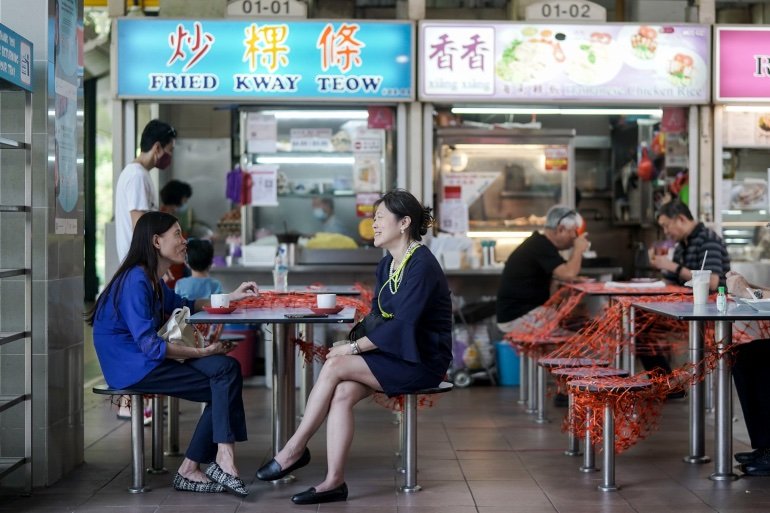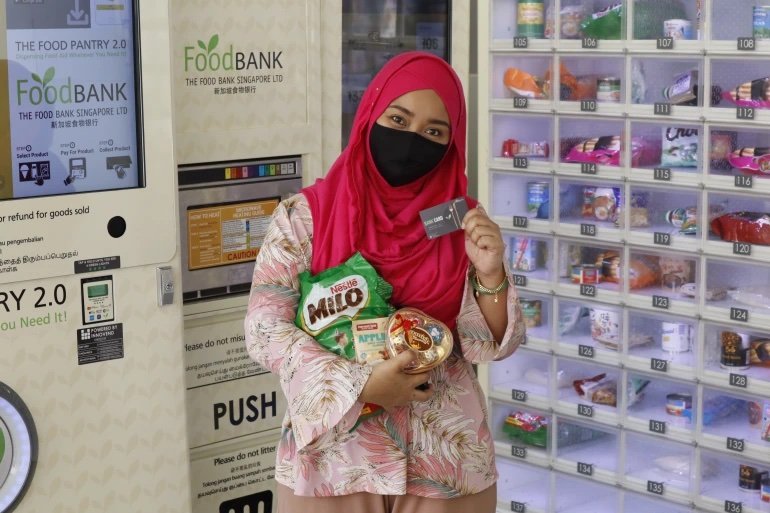As COVID-19 rages, more in Singapore go hungry
By Toh Ee Ming
People dropping meals, buying cheapest products as pandemic leaves contract and low-paid struggling to make ends meet.
Singapore – After being let go from his part-time job as a waiter last year during the pandemic, Danny Goh hit rock bottom.
For eight months, he struggled to find work to support his wife and four young children. The family survived on instant noodles, bread dipped in coffee, and biscuits, getting by on the goodwill of relatives and church friends.
While Goh has found a new commission-based job getting people to sign up for government skills upgrading and training courses, his income fluctuates between 800 Singapore dollars ($594) and 2,800 Singapore dollars ($2,078), which is barely enough for their large family.
He perpetually finds himself cash-strapped.
To save money, the family has started eating only two meals a day – simple dishes like chicken soup with rice or potatoes.
Goh often skips meals or eats once a day so that his children can have a bigger share.
Where their fridge used to be stuffed with fresh fruit, chicken, pork and beef, soft drinks and snacks, all of this is now a luxury, and eating out is out of the question.
“It’s a huge pay cut, and honestly it’s one of the hardest and most demoralising periods of my life. Times are really tough,” said the 61-year-old who rents a two-room public housing flat in the northern part of the island.
In a food paradise and wealthy city-state like Singapore, food insecurity is a phenomenon that exists primarily behind closed doors. But as elsewhere in the world, COVID-19 has hit the disadvantaged the hardest, typically the lowest earners in precarious jobs, who have few safety nets and insufficient wage and labour protections.
Earlier this year, a six-month study by local charity Beyond Social Services found that the median household income of families who sought the group’s help had plunged from 1,600 Singapore dollars ($1,187) before the COVID-19 pandemic to just 500 Singapore dollars ($371).
More worryingly, a second study, which detailed the effect of the pandemic on people renting government-owned flats between July and December 2020, found food insecurity was increasingly prolonged.
Residents told Beyond that they sometimes coped with the lack of food by filling themselves up with liquids or starches, buying cheap and filling items, and making choices based on financial considerations rather than nutritional value.
For instance, some families would eat only one meal a day or give their children coffee creamer in hot water because they could not afford formula milk. The report warned the issue could escalate into a serious public health matter, with links to increased mental stress and the development of chronic health conditions.
In 2019, Singapore ranked as the world’s most food-secure nation in the Global Food Security Index.
However, one in 10 Singaporeans experienced food insecurity at least once over 12 months, reported a study by the Singapore Management University’s Lien Centre for Social Innovation. Out of this, two in five experienced food insecurity at least once a month and many of these households did not seek food support, citing embarrassment, being unaware of what was available and the belief that others needed it more than themselves.
“To a regular Singaporean, food is a national pastime,” said Beyond’s Deputy Executive Director Ranganayaki Thangavelu. “But we may not realise how poorly others are eating, how they have to make difficult choices for each meal, and how food is just a necessity to sustain them. When they are confronted by this inequality daily, it wears them down over time.”
Barely ‘staying afloat’
Before COVID-19, eating out used to be a regular affair for 35-year-old Joshua (not his real name), his homemaker wife and their 6-year-old daughter.
But all that changed when the former studio technician was abruptly let go due to massive cost-cutting measures during the pandemic last March. He took on a contract job as a security guard, clocking 12-hour night shifts four times a week, earning 1,400 Singapore dollars ($1,039) a month – half his previous salary.
These days, every time Joshua gets his pay, the couple sits down to figure out how to stretch their monthly food budget of 400 Singapore dollars ($297).
Usually, that means buying frozen chicken rather than fresh, looking out for value buys and discounts, buying in bulk and switching to cheaper brands.
The remaining money goes to paying rent for their flat, utilities, phone and internet bills and other day-to-day expenses, with little to no buffer of savings. For a treat, they take their daughter out for a fast food meal once a month.
Joshua says that so far, they have been able to get by, helped by rations of dried food, fruit and vegetables from a local charity.
Despite the uncertainty, he is sanguine about the situation, saying that he is lucky he is still young and able to find work.
“We manage to stay afloat. For now, this is enough for my family and me to manage,” he said. “The pandemic has taught us a lesson about resilience and fighting on.”
Charities that Al Jazeera spoke to say that new sectors of society have been seeking food aid because of the pandemic, including younger “gig” workers whose projects have dried up and even middle-income families living in bigger public housing flats or private homes. About 85 percent of Singaporeans live in government-subsidised apartment blocks.
“On the outside, the house looks cushy and polished, but then the kids tell us that their mother hasn’t eaten for two days,” said The Food Bank Singapore co-founder, Nichol Ng. “For the food to be impacted, it means they are scraping the very bottom of the pot.”
Each time the government’s multi-ministry task force handling COVID-19 announces new restrictions, the charity is flooded by requests from people writing in to ask for food.
Singapore recently announced that its COVID-19 restrictions would be extended until November 21, after registering thousands of new COVID-19 cases daily.
“This means we have a lot of people who are super vulnerable and who can’t feed themselves. To know they are literally a paycheque away from not eating, it’s really scary and worrying,” Ng said.
Offering a Lifeline
Under its Feed the City initiative last year, The Food Bank Singapore distributed one million meals.
Driven by a belief in giving beneficiaries the “autonomy of choice and dignity”, it also rolled out more neighbourhood vending machines stocked with anything from frozen bento meals to drinks, snacks and rice. The group says the machines, which the residents access with special cards, reduce the risk of the food going bad when left outside someone’s house in the tropical heat.
The charity has also rolled out other innovations, including a bank card programme that allows beneficiaries to redeem meals from food establishments.
Food from the Heart, another charity, has also seen demand surge and is now delivering 10,000 ration packs a month compared with 5,000 before COVID-19 hit.
They have also enlarged the size of their food packs after families ran out of supplies during coronavirus-related lockdowns.
“With more conversations about food insecurity, there’s less stigma of people admitting they get food support, especially those more able-bodied who have lost a job,” said chief executive Sim Bee Hia.
“We expect the pandemic’s impact to be prolonged and we just have to react and be nimble to make sure we keep the food going to those who need it as long as they need it.”
Despite the proliferation of initiatives and the rising volume of food aid, the Beyond report notes that efforts remain patchy and ad hoc, with some getting too much assistance and others not knowing how to get the help they need.
Ng said: “There’s too many ground-up initiatives and corporations with big hearts but they assume it is these few places that need help. As a result, there’s duplicated food efforts in certain neighbourhoods, while others fall through the cracks.”
To solve this, her team plans to create an online database – or “feeding directory” – detailing the range of food aid initiatives by neighbourhood. It is also working on a food-banking app where beneficiaries can submit real-time food requests to donors, while donors share the type and quantity of food they have on hand.
The Ministry of Social and Family Development (MSF) says it recognises “there are vulnerable groups within our community who require support“, and has introduced a series of measures to address the issue since the pandemic, including grants and income relief as well as grocery and food vouchers for the less well-off.
These measures come on top of the existing ComCare programme, which provides social assistance for low-income individuals and families.
“In terms of food insecurity, Singapore has fared relatively well internationally, with rates remaining consistently low, due to our economic and social policies and collective community efforts to support those in need,” an MSF spokesperson said in an email response to Al Jazeera.
The ministry noted that about 4.5 percent of the population in Singapore was estimated to face moderate to severe food insecurity, according to the 2021 report on the State of Food Security and Nutrition in the World published by the UN Food and Agriculture Organisation (FAO).
This was lower than in other developed economies such as the United States (8 percent), New Zealand (14 percent), Australia (12.3 percent) and South Korea (5.1 percent), it added.
But as the pandemic rages on and businesses continue to bleed, Goh is fearful of the prolonged economic impact on families like his.
“I never imagined that the situation would become worse,” he said. “There seems to be no end in sight.”
SOURCE: AL JAZEERA
Link to article here.




